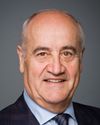Thank you, Minister.
And thank you, Chair.
And sir, thank you for your question.
I will look into any hesitation there was in charging down to Guelph to talk to Canada's youth about the Canadian Forces, because it's certainly important to us that the people understand the opportunities, and we definitely have a role to play in improving Canadians' understanding of the Canadian Forces. So I apologize if people appeared to be dragging their feet.
As the minister has said, in the growth of the Canadian Forces at the moment, we have programmed numbers for the regular force. At present we sit just above the programmed level of 68,000 that has been established for us at this point in CF growth. In fact, we were more than 1,000 above that when I came in a year ago and we've put some measures in place to get us back to that mandated number, because paying for more people than you have money for takes money away from other things.
We're just above 68,000 now and in very healthy shape. But we have reduced the amount of recruiting over the last year to make sure that we are able to manage that throughput. Our attrition is down, too, strangely enough, I guess because the economy is a bit down. But the Canadian Forces are certainly up and people are excited about what they're doing.
So it's a very tough machine to manage, but we have not stopped recruiting. In fact, we continue to recruit because you need a throughput just to keep the machine oiled and to keep new blood coming in, but fewer than before.
There are a couple of areas where we're putting a lot of effort. One is in our stressed trades, particularly technical trades, where we don't have enough people coming into the Canadian Forces with the skill set to feed our requirements in key areas. So we do put a lot of effort and energy into attracting people into those occupations, and we track the attrition from those occupations very carefully because they tend to be quite valuable people in other sectors of the Canadian economy.
We are also focused on opportunities for members of our reserve force who have served in Afghanistan, who have spent some time on full-time service, and who wish to transfer to the regular force. We do give them pride of place at the start of the recruiting year, so that those who do want to shift over to regular force service have the opportunity to do so where possible. I think you would agree with me that those who have served their country in this way have earned the right to first refusal, and it is certainly a great way to avoid excess costs to bring in proven folks who are already trained to a certain level, and fold them into the regular force.
For all of those reasons, we are recruiting fewer people than we were over the last number of years as we were growing our force, and we'll continue to adjust the level of recruitment to be able to manage that force level at those mandated levels as we move forward.
I hope that addresses your question.





